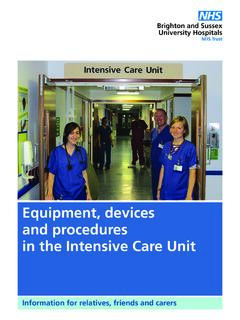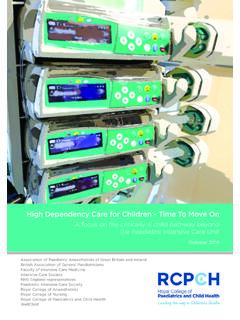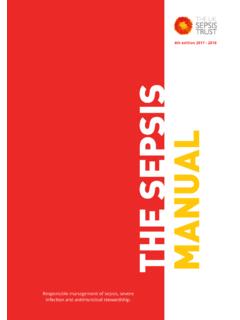Transcription of DEFINITION AND CHARACTERISTICS FUNCTIONS AND …
1 Finally, strong arguments can be made that cost-effective-ness analysis fails to capture important dimensions of the indi-vidual utility and thus the social welfare that accrues fromthe provision of health services, especially those relating tohigh-cost and low-frequency are, therefore, highly skeptical about the feasibility ofproposing a formulaic and purely quantitative response to thequestion of how to achieve an appropriate allocation ofresources to the referral hospital level. Although perhaps unsat-isfying for some readers, this chapter attempts instead to providean overview of the critical features of and challenges relating toreferral hospital care in developing countries and a guide to themany issues that decision makers face in setting policy for thislevel of care .
2 We suggest that planners need to adopt a far morequalitative and intuitive approach to deciding on the appropri-ate allocation of resources for referral hospitals than for otherhealth care interventions. Such an approach is informed by amore extensive listing of the roles of referral hospitals and theirdirect and indirect benefits and costs to society. We acknowledgethat analysis of the value of referral hospitals is bedeviled by thefact that, when judged empirically, they do not work as they aresupposed to. The chapter, therefore, considers the key problemsfaced in the real environment in which referral hospitals operatein poor countries before reviewing what needs to be done toimprove their functioning, drawing in particular on the authors knowledge of South Africa and the AND CHARACTERISTICSAny hospital, including a district hospital, will receive referralsfrom lower levels of care .
3 Indeed,referral can be defined as anyprocess in which health care providers at lower levels of thehealth system, who lack the skills, the facilities, or both to man-age a given clinical condition, seek the assistance of providerswho are better equipped or specially trained to guide them inmanaging or to take over responsibility for a particular episodeof a clinical condition in a patient (Al-Mazrou, Al-Shehri, andRao 1990). Furthermore, higher-level hospitals in developingcountries do not treat only referred patients; tertiary hospitalsare frequently the first point of contact with health services formany referral hospitals from district hospitals,therefore, requires consideration of the different resources usedby different levels of hospital.
4 Such a differentiation will tend torevolve around three features the availability of increasinglyspecialized personnel, of more sophisticated diagnostic tech-nologies, and of more advanced therapeutic technologies that permit the diagnosis and treatment of increasingly com-plex volume, including this chapter, uses a standard defini-tion of hospital levels (Mulligan and others 2003). Table some of the commonly used alternative terminologyfor different levels of hospitals. Note that this chapter deals onlywith general that is, multispecialty secondary and tertiaryhospitals.
5 Specialized hospitals, such as psychiatric, substanceabuse, tuberculosis, infectious diseases, and rehabilitation hos-pitals, clearly have important roles to play in a well-functioningreferral system. However, they are attended by specific featuresand challenges, account for a relatively small share of overallresources, and operate in a significantly different manner thangeneral hospitals AND BENEFITS The FUNCTIONS of referral hospitals may broadly be categorizedinto (a) the direct clinical services provided to individualpatients within the hospital and the community and (b) a set ofbroader FUNCTIONS only indirectly related to patient | Disease Control Priorities in Developing Countries | Martin Hensher, Max Price, and Sarah AdomakohTable and Terms for Different Levels of HospitalDisease Control Priorities Project: terminology and definitionsAlternative terms commonly found in the literaturePrimary-level hospital:few specialties mainly internal medicine,obstetrics and gynecology, pediatrics, and general surgery, or just generalpractice.
6 Limited laboratory services available for general but notspecialized pathological analysisSecondary-level hospital: highly differentiated by function with 5 to10 clinical specialties; size ranges from 200 to 800 beds; often referredto as a provincial hospitalTertiary-level hospital:highly specialized staff and technical equipment for example, cardiology, intensive care unit, and specialized imagingunits; clinical services highly differentiated by function; could haveteaching activities; size ranges from 300 to 1,500 bedsDistrict hospitalRural hospitalCommunity hospitalGeneral hospitalRegional hospitalProvincial hospital (or equivalent administrative area such as county) General hospital National hospitalCentral hospitalAcademic or teaching or university hospitalSource:Definitions from Mulligan and others 2003, of Clinical Services Provided The primary function of the referral hospital is to providecomplex clinical care to patients referred from lower levels.
7 However, no agreed international DEFINITION exists of which spe-cific services should be provided in secondary or tertiary hos-pitals in developing countries. The exact range of servicesoffered tends to vary substantially, even between tertiary hospi-tals within the same country, as much because of historicalaccident as deliberate South Africa, the National Department of Health isattempting to improve the quality and accessibility of referralhospital services through development plans that will try toensure that hospitals at each level move toward providing acomprehensive set of clinical services (National Department ofHealth, South Africa 2003).
8 The department has developed atarget template of services (table ) for regional (secondary)hospitals, tertiary hospitals, and so-called national referralservices (which will be offered at only a small number of theReferral Hospitals |1231 Anesthetics Diagnostic radiologyX-ray, CT scan, ultrasound, fluoroscopyGeneral medicine Echocardiography, stress electrocardiogram Specialist immunology nurseRegional intensive care unit Diabetes, endocrine clinicGastroenterology, including endoscopy,proctoscopy, sigmoidoscopy, colonoscopy(with general surgery)Geriatric careGenetic nurse and counselingOncology palliation and basic care Neurology basic careSpirometry and oximetryBasic rheumatologyGeneral surgery Regional burns service24-hour trauma service, accident andemergencyMental health (psychiatry Acute inpatient and outpatient treatmentand psychology))
9 Child and adolescent psychiatryElectroconvulsive therapy Liaison psychiatrySatellite clinicsObstetrics and gynecology Emergency obstetrics and gynecologyUltrasound, prenatal diagnosisKangaroo mother care Basic urogynecologyOrthopedic surgeryGeneral orthopedic surgery24-hour trauma service, accident andemergencyPediatrics Neonatal low and high careGeneral pediatric medicine serviceGeneral pediatric surgery (general surgeon)Rehabilitation centerPhysiotherapy, occupational therapy,orthotics and prosthetics, speech therapy,dietetics, podiatryAcute rehabilitation team (Continues on the following page.)Table Service Configurations by Level of Referral Hospital, South AfricaSpecialist services Components Specialist services Components available on siteexplicitly includedavailable on siteexplicitly includedRegional (secondary)
10 HospitalsTertiary hospitalsAnesthetics Burns unitSpecialized burns intensive care unit andoperating theaterClinical pharmacology specialistCritical care and intensive Full intensive care unit servicecare unitDermatology Inpatient and ambulatory treatmentDiagnostic radiologyX-ray, multislice CT scan, ultrasound,fluoroscopy, mammography, color Dopplerultrasound Ear, nose, and throat surgery Gastroenterology General medicine As regional plus:AngiographyCoronary careEchocardiography, stress electrocardiogramEndoscopy, proctoscopy, sigmoidoscopy,colonoscopy (with general surgery)Genetic nurse and counselingOncology palliation and basic care General surgery Complex and high-acuity careInfectious diseases Mental health (psychiatry Child and adolescent psychiatry, old-age and psychology)psychiatry, forensic psychiatry, substanceabuse treatment, liaison psychiatry,treatment for eating disorders, inpatientpsychotherapy, social psychiatry, acutepsychotic (complicated) care , acutenonpsychotic (complicated)













![Pneumonia (Ventilator-associated [VAP] and non- ventilator ...](/cache/preview/d/3/6/5/6/9/b/6/thumb-d36569b6dc8a7d8c6714d2f268ee79b7.jpg)





